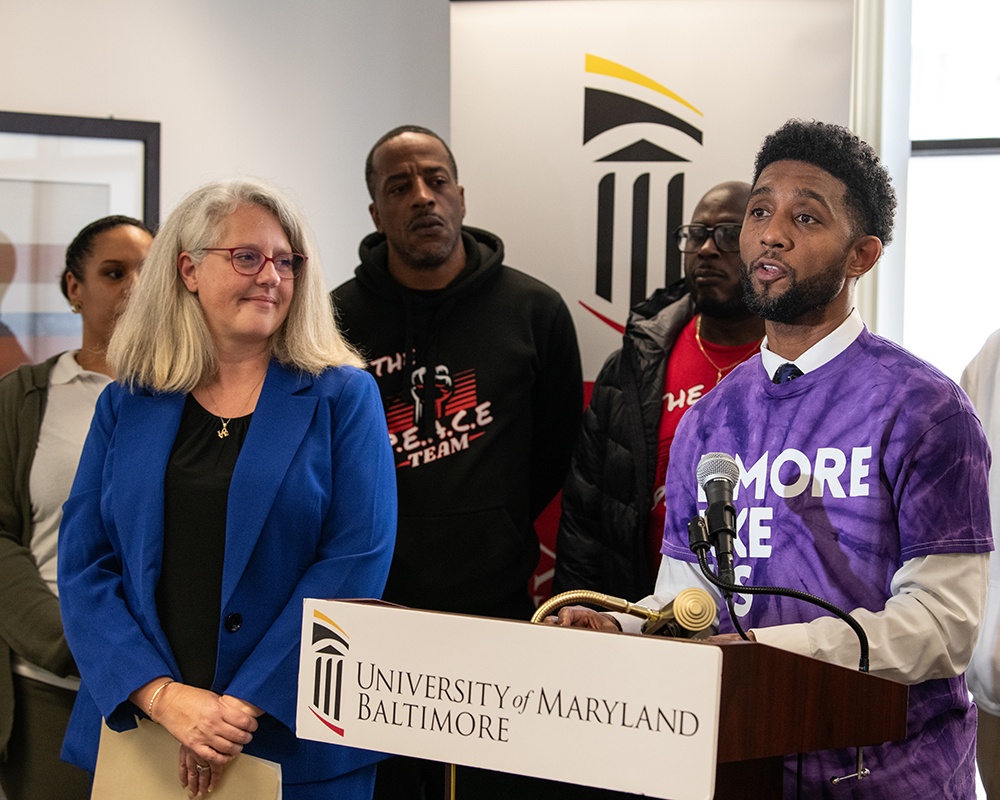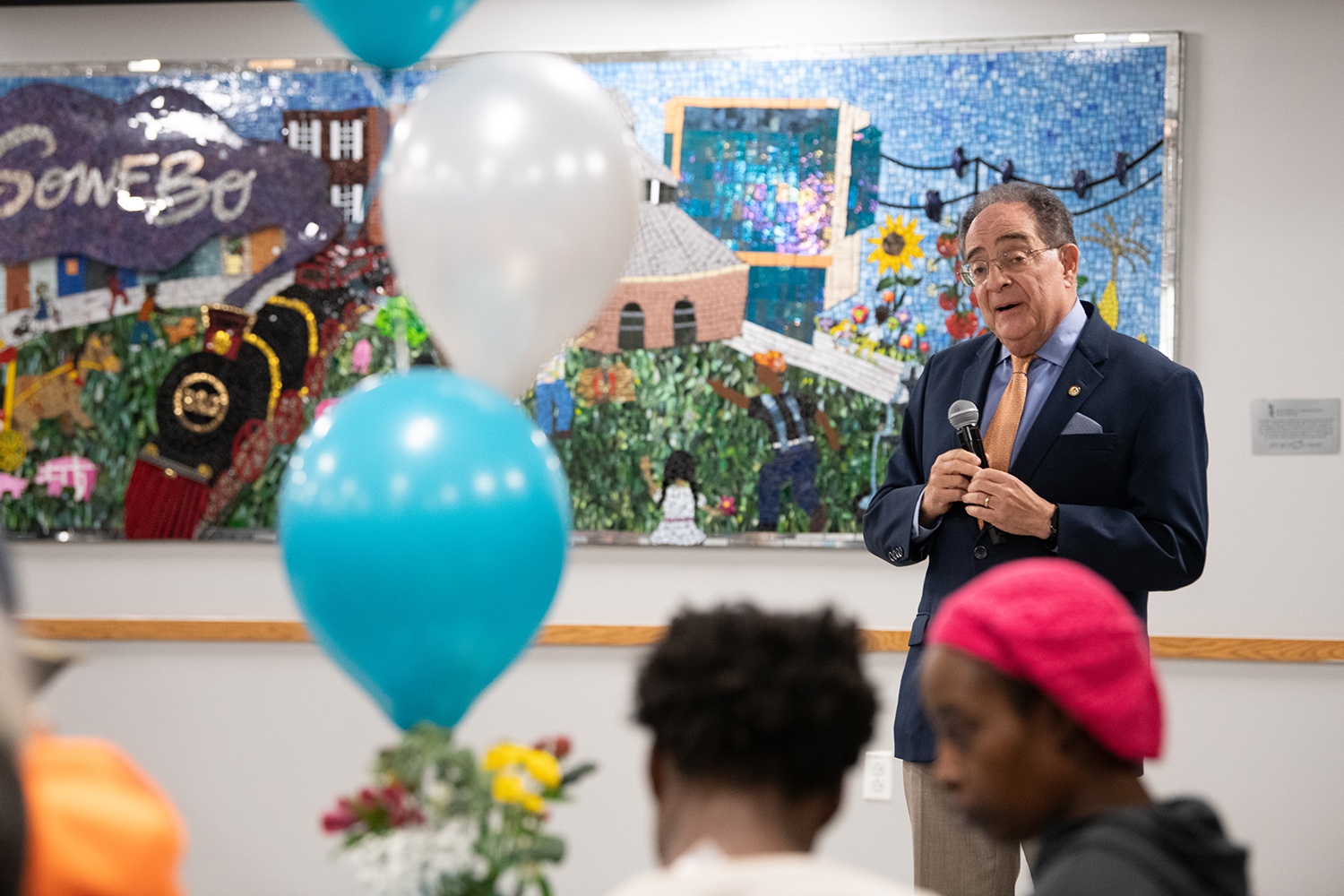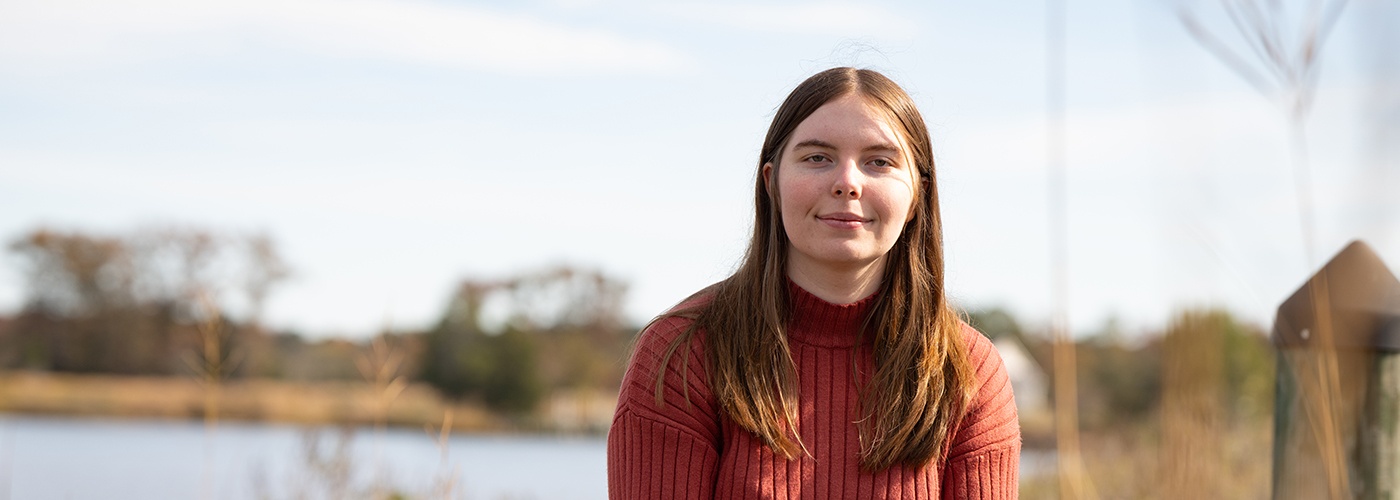
When community members walk through the doors of the Embrace Resource and Reentry Center (ERRC) in West Baltimore, they’re often seeking something specific — a job lead, help obtaining vital records, housing assistance, or recovery support. The University of Maryland, Baltimore (UMB) EMBRACE Initiative center offers all of that and more, but its deeper strength lies in how it operates. At the ERRC, support begins with respect and understanding, qualities woven into every encounter that follows.
Kahlilah Saleem is one of many who found that approach essential. A justice-involved community member who served six years in a Cuban prison, Saleem returned to Baltimore determined to move forward. She completed a year of AmeriCorps service and earned certification as a community health worker, but job prospects dried up as some local nonprofits lost federal funding. To broaden her opportunities, the ERRC connected her with peer recovery specialist training, along with other support. Those steps led to her recent appointment to Baltimore’s Trauma-Informed Care Task Force.
Her experience navigating those challenges underscores why centers like the ERRC matter. “If companies can rebrand, so too can people,” Saleem said.
The ERRC is one arm of UMB’s EMBRACE Initiative, which was launched in 2021. The initiative is grounded in the Rev. Dr. Martin Luther King Jr.’s vision of a Beloved Community — a society rooted in justice, equal opportunity, and mutual care, where poverty and hunger are unacceptable and conflict is resolved through understanding and reconciliation rather than punishment. In practice, EMBRACE centers the wisdom of those most affected by harm and builds low-barrier pathways to stability and leadership for youth, returning citizens, and neighbors with lived experience.
For EMBRACE’s executive director, Kyla Liggett-Creel, PhD, LCSW-C — better known across Baltimore as “Dr. K” — the philosophy of partnership isn’t abstract; it guides every decision. “As we started this work, UMB was clear that we did not want to continue the pattern of harm that has been done to this community, especially marginalized groups,” she said.
The first efforts of EMBRACE proved that new approaches can break old cycles. What started in West Baltimore has grown into a model for how other institutions can reimagine their role in advancing community wellness.
From Talk to Action
In late 2021, community representatives including business owners, police, and community advocates gathered to discuss the future of the Eutaw Street corridor. Their purpose: making the soon-to-be-refurbished Lexington Market as successful as possible. With numerous open-air drug sales taking place within a one-block area along Eutaw, traditional responses — more surveillance and increased arrests — were on the table. But UMB advocated for a different path.
As an anchor institution, UMB recognized its responsibility to engage with communities as partners rather than as outsiders arriving with ready-made solutions. That meant recognizing community members not just as beneficiaries, but also as collaborators in shaping change.
“Dr. K really, really believes in the people that live in this community,” said Marvin Garner, a peer recovery specialist and a credible messenger at the EERC. “In those earliest conversations, she pointed out that the people that live here are stakeholders as well.”
Liggett-Creel emphasized that this wasn’t just a matter of principle — it was essential to lasting impact. “It’s important to partner with community members so that the wisdom of their experience guides the research, intervention, and advocacy,” she said. “This also allows for sustainability, because the information and strategies and policy changes are led by community members and not only by University staff and faculty.”
This goal to center community wisdom quickly shaped EMBRACE’s early steps.
The UMB Police and Public Safety Department started by investing in a pilot program to hire peer recovery specialists and recently incarcerated individuals — known as returning citizens — to conduct outreach and offer direct support. Social work interns were embedded with Police and Public Safety’s Community Outreach and Support Team (COAST), and a local business donated storefront space — which became the ERRC’s initial location — to launch walk-in services.
The first such service was provided on Dec. 7, 2021, when a community member was given help with finding a job. What began as conversations just a few weeks earlier had shifted into action, creating space for change to take root.
Building Safety Through Human Connection
By March 2022, EMBRACE was partnering with the PEACE Team, a local nonprofit dedicated to violence prevention. Their aim was to reduce crime and violence often associated with the open-air drug market on Eutaw Street — not by removing people, but by understanding their needs and connecting them to resources through EMBRACE.
The results were striking. By April 2022, open-air drug sales had dropped by more than 50 percent. Community members engaged with ERRC staff more than 435 times, receiving support such as employment assistance, vital records, drug treatment referrals, housing help, vocational training, and expungement.
This progress wasn’t just about reducing numbers. It was about building trust and creating a welcoming place where people could find real help.
Garner, who has played a vital role at the ERRC since its launch, describes it as a “one-stop center.” He explained, “Our approach brings together credible messengers, peer recovery specialists, UMB law enforcement’s COAST, licensed social workers, social work interns, and other organizations to remove barriers that traditional social work alone has not been able to address.”
Jeremiah Savage, LMSW, who began as an intern and now serves as one of the center’s full-time social workers, said the ERRC’s focus on the expertise of people with lived experience impacts staff as well as clients. Calling his time at the ERRC “life-changing,” Savage stressed, “If I were to go to a lot of other agencies, I would be trained by someone, who was trained by someone, who was trained by someone, who was trained by someone to do this job. What I get to do here is to learn from people who have lived this. I’m not learning by word of mouth. And I also learned to do my work in a way that really respects people.”
That same respect shapes the ERRC’s day-to-day operations, which are intentionally designed to be as low-barrier as possible.
“If someone walks in and says, ‘I need something,’ we sit down and address it right away,” Savage said. “We don’t say, ‘Come back in three weeks.’ We want people to know we’re committed to their situation, so they feel comfortable returning and continuing to work toward their goals.”
Garner added that the center maintains processes for services, but flexibility is key. “We’ll accept you whether you have an appointment or walk in off the street,” he said. “That’s what being low-barrier means.”
The ERRC’s impact is reflected in its data. Since its launch, the center’s staff has recorded over 8,635 interactions and touchpoints with community members, including 2,223 first-time engagements and more than 5,165 follow-ups. Employment assistance and vital records remain the most requested services, with over 1,600 cases of job support. There have been 1,881 requests for vital document recovery. Housing, behavioral health services, conflict mediation, vocational training, food access, and transportation assistance are also common needs. As of the latest data, the ERRC has helped clients achieve over 3,700 tangible goals, including securing jobs, enrolling in drug treatment, and obtaining essential documents like IDs and birth certificates.
Centering Lived Experience
EMBRACE operates across four interconnected areas — programming, academics/scholarship, research/evaluation, collective impact — and it centers lived experience as the foundation of each. The credible messenger model is key to this approach.
“Books and journals do not always tell the full story. It is only through lived experiences that the intricacies of the issues and needs can be fully understood,” Liggett-Creel said. “By having someone who has also experienced that harm and has been able to navigate through the systems successfully — it allows the community member to also work with that person to overcome the systemic barriers that have been put in place.”
That belief comes to life every day through the work of Willie Hamilton and Gordon Pack, close friends who served decades in prison and were both released under Maryland’s Juvenile Restoration Act. Now, they’re advocates, mentors, and reentry coordinators at the ERRC, where they use their experience to guide others through one of the hardest transitions a person can face.
“We went through the process of coming home after doing long, long terms of incarceration and trying to figure out life in a new way, in a new world,” Hamilton explained, adding that while many people want to forget what they’ve been through, he and Pack felt a responsibility to stay involved.
“We still want to help, because we understand the need,” he said. “I was incarcerated when I was 16. I was a child. So coming home as a 47-year-old and trying to figure things out was very difficult.”
Everything from mental health care to basic technology — phones, credit cards, even text messaging — were barriers. But going through it helped them understand what others would face.
One major issue, Pack explained, is navigating fear. After years in a tightly controlled environment, normal sounds, such as children crying or people laughing, can trigger anxiety. He added that routines followed in prison can become obstacles once they return home, making simple daily tasks unfamiliar.
“After so much time in prison, you’re used to other people preparing the food. And you say, ‘Look, it’s time to eat.’ So you’ll sit in the kitchen and watch the refrigerator, but you don’t make anything to eat because you’re conditioned not to,” Pack described. “You don’t know what to buy in the store, because the commissary in prison has limited options. And those are real issues. People might have assumptions, but you don’t know if you haven’t lived it.”
That lived understanding is central to the pair’s work. In addition to peer mentoring, case management, and help with practical needs such as transportation or obtaining IDs, they guide others through the process of adjusting to a world that has changed since many were last free.
For clients like Saleem, such help is crucial. She noted, “Gordon Pack has helped me tremendously by following up on my interview prospects and reminding me that I’m not in this process on my own.”
The Challenge of Building Change That Lasts
For Liggett-Creel, EMBRACE is about more than delivering services — it’s also about reshaping the systems that created harm in the first place. Outdated procurement processes, administrative burdens, and credentialing requirements too often exclude grassroots leaders and returning citizens.
“Systems created the environment that caused groups of people to be marginalized, and therefore it is the responsibility of systems to address this harm and in fact change the systems to center those who have been marginalized,” she said.
That commitment to reform and collaboration has earned recognition across the city. In addition to being named UMB’s 2025 Public Servant of the Year, Liggett-Creel was recently honored by the Baltimore City Council with a congratulatory resolution for her leadership and EMBRACE’s contributions to the community.
Zeke Cohen, Baltimore City Council president, underscored the importance of that work, saying, “The EMBRACE Initiative represents the kind of cross-sector collaboration Baltimore needs to strengthen families and communities. Embedding trauma-informed care into our city’s systems is essential to addressing root causes and breaking cycles of harm.”
Other officials agree that EMBRACE’s partnership model has been a key factor in Baltimore’s progress on reducing violence. Stefanie Mavronis, director of the Mayor’s Office of Neighborhood Safety and Engagement, said, “Baltimore is seeing historic decreases in homicides and nonfatal shootings because of EMBRACE and other partners doing the hard work on the ground to get upstream and prevent violence. Dr. K and her team show up with care and compassion every day — from helping mediate conflicts to supporting neighbors returning from incarceration. They continue to be a key partner in Baltimore’s community violence intervention ecosystem and our collective work to build safer, stronger neighborhoods for all Baltimoreans.”
For community members like Saleem, EMBRACE’s impact runs deeper than policy or numbers. Its strength lies in being a place staffed by people who draw on their own experience to support others. “To me, West Baltimore is the heart of our city,” she said. “So many community ambassadors have made legendary change in the midst of generational neighborhood disinvestment.”
Read more about Kyla Liggett-Creel in this issue of CATALYST.



